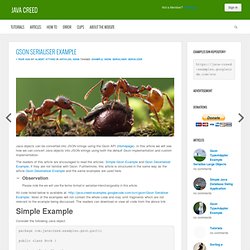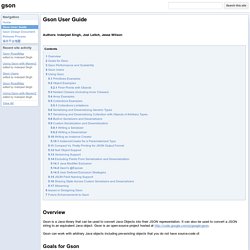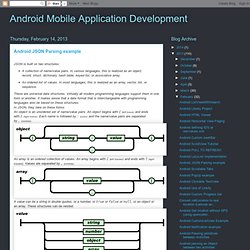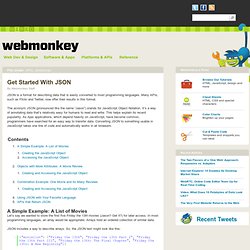

Gson & Deserialization of Objects Containing Arrays. After my practicum team and I banged our collective heads against the wall for several hours trying to force Gson to deserialize json arrays into a collection of complex classes containing their own collections, we chose to go another route entirely.

Our problem at the time was that we had blinders on and couldn’t walk away from using Javas Collections library. I came to realize today that Gson does a fantastic job of deseralizing classes with any depth of arrays so long as those json arrays are actually represented as primitive arrays in your java class. For example: let’s say you had the following json: My previous attempts to deserialize this object might have been to create the following class: And deserialize using the following code (per the user guide): We tried a good deal of tricks to get this to work but never had any real luck with it.
GSON Serialiser Example. Java objects can be converted into JSON strings using the Gson API (Homepage).

In this article we will see how we can convert Java objects into JSON strings using both the default Gson implementation and custom implementation. The readers of this article are encouraged to read the articles: Simple Gson Example and Gson Deserialiser Example, if they are not familiar with Gson. Furthermore, this article is structured in the same way as the article Gson Deserialiser Example and the same examples are used here. Observation Please note the we will use the terms format or serialise interchangeably in this article. All code listed below is available at: Serialiser Example/. Simple Example Consider the following Java object. package com.javacreed.examples.gson.part1; public class Book { private String[] authors; private String isbn10; private String isbn13; private String title; } This is a simple Java class representing a book.
Types of JsonElement The above image shows all types of JsonElement. Gson User Guide - gson. Serializing and Deserializing Collection with Objects of Arbitrary Types Sometimes you are dealing with JSON array that contains mixed types.

For example: The equivalent Collection containing this is: Collection collection = new ArrayList(); collection.add("hello"); collection.add(5); collection.add(new Event("GREETINGS", "guest")); Where the Event class is defined as: class Event { private String name; private String source; private Event(String name, String source) { Android JSON Parsing Tutorial. Android JSON Parsing example. JSON is built on two structures:A collection of name/value pairs.

In various languages, this is realized as an object, record, struct, dictionary, hash table, keyed list, or associative array.An ordered list of values. In most languages, this is realized as an array, vector, list, or sequence.These are universal data structures. Virtually all modern programming languages support them in one form or another. It makes sense that a data format that is interchangeable with programming languages also be based on these structures.In JSON, they take on these forms:An object is an unordered set of name/value pairs. An object begins with { (left brace) and ends with } (right brace). An array is an ordered collection of values. A value can be a string in double quotes, or a number, or true or false or null, or an object or an array. A string is a sequence of zero or more Unicode characters, wrapped in double quotes, using backslash escapes. MainActivity .java JSONParser.java code is given below <!
Get Started With JSON. JSON is a format for describing data that is easily converted to most programming languages.

Many APIs, such as Flickr and Twitter, now offer their results in this format. The acronym JSON (pronounced like the name “Jason”) stands for JavaScript Object Notation. It’s a way of annotating data that’s relatively easy for humans to read and write. This helps explain its recent popularity. As Ajax applications, which depend heavily on JavaScript, have become common, programmers have searched for an easy way to transfer data. A Simple Example: A List of Movies Let’s say we wanted to store the first five Friday the 13th movies (Jason?